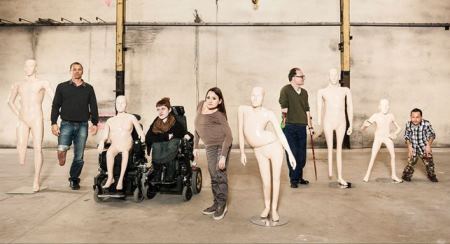Mannequins who have disabilities –why not?
by Sara
As a young woman, I look to the media for almost everything—and everyday I’m being bombarded with images of how a young woman should look. You should be skinny but muscular. Not too much muscles or you’ll look weird. You should have a flat stomach, perfect butt and perfect bra size.
I know this is not realistic. Still, these images leave millions of young girls worrying about what’s imperfect about themselves. Images of young men in the media leave them struggling to better themselves, too. They’re supposed to be muscular with six-pack abs and amazing biceps so they can be the eye-candy/womanizer in their friend circle.
I often see magazines berating female celebrities for looking TOO skinny or fat, and I know that many young teenagers get called names on social media based on their weight. Being attacked due to your size or weight is just as wrong as being attacked because you have a disability.
Fact: in 2010, the average woman size was size 14…wait, what?! Yup. Even so, stores tend to carry more clothing in the sizes of zero and two (That’s 12 sizes below the average) instead of carrying more sizes in the double digits. Why? Because of this crazy concept of what the average size should be for women .
A few weeks ago I read Plus Model Mag’s article on REAL body image campaigns. These campaigns are taking place in department stores like Nordstrom and JcPenney, and I am THRILLED to see change, especially in 2014 (the peak of our social media era). My colleague MacKenzie Olsberg wrote a post here last December about Pro Infirmis, an organization in Switzerland for people with disabilities that created a series of mannequins based on real people.
The mannequins were placed in the front windows of shops on Zurich’s main downtown street, Bahnhofstrasse, in honor of International Day of Persons with Disabilities on December 3 last year. The campaign was called “Because Who Is Perfect? Get Closer,” and it was exciting to see the beginning of an open dialogue about what really is a perfect body. Click here to see the process that went into making these unique mannequins. Perhaps one day in the near future, we won’t be disappointed when we try to look like the mannequin in the shop window.
I’ve also read several articles on Swiss’ mannequin body shape changes and on UK’s reform for bigger sizes mannequin models.
I’m thrilled to see changes happening, not only with the size aspect of women’s bodies, but for people with disabilities.
Often people who are not reflected in the advertisement or the mannequin sizes cannot see themselves in that store’s clothes, but with changes like these, now they can. These changes could help all of us feel better about our size, our body shape, and our disabilities.
So how about we start focusing on these sort of campaigns rather than linking to posts about skinny celebrities? It’s time to start embracing the normal, and the normal is ALL OF US. Let’s start supporting each other in this new path in the eye of the media. Let’s start embracing diversity and the differences of our bodies. Most of all, let’s start loving ourselves.







